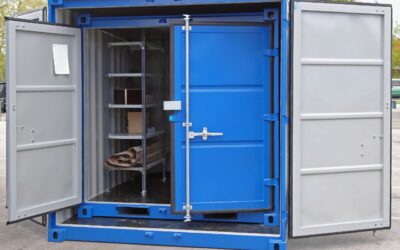If you’re looking to hire or buy a shipping container for the first time for transport or storage purposes, you’ll quickly find there’s a variety of options to choose from. One of the main choices will be deciding whether to go for a standard shipping container or a high cube shipping container.
But what exactly is the difference and what are the benefits and advantages of choosing one over the other? We thought we’d explore this issue in a bit of detail so you can make an informed decision before confirming your order.
What is the difference between a standard and a high cube shipping container?
A standard 20ft shipping container has the dimensions 6,058mm (L) x 2,438mm (W) x 2,591 mm (H). A 20ft high cube shipping container has the same length and width dimensions but is 1ft (305mm) taller. This means the high cube container has more volume (37.4m³ compared to 33.2m³ for the standard) making it also slightly heavier (2,250kg compared to 2,060kg).
Interestingly, the maximum payload of these containers is virtually identical. As a matter of fact, the standard container has a marginally higher payload (28,420kg vs 28,230 kg) due to the effect of the higher walls and integrity of the structure.
When to use a high cube shipping container
With the difference between the two understood, it’s important to establish what this means in practical, real-world situations.
We’ll start with the high cube shipping container, looking at instances when it should be the preferred choice.
Transporting oversized items
For those looking to transport or store anything that’s slightly oversized, a high cube container is definitely the more appropriate option. This is primarily why the high cube container exists in the first place.
Items and objects like machinery, electrical equipment, sculptures, statues etc often need that additional foot of height in order to fit comfortably in the space.
One must bear in mind too that the internal space is ever so slightly smaller than the external measurements referenced earlier so if it looks like it’ll be cutting it close with the standard, the high cube is by far the safer bet.
The extra height also makes them popular options for those in agriculture and farming, especially as additional storage, temporary or permanent.
Transporting products in bulk
Large manufacturers often take advantage of the extra volume of a high cube container when transporting products in bulk. The difference of 4.2m³ might not sound like much on the face of it but in real terms, it equates to about an additional 500 shoe boxes worth of storage.
That fact alone shows the potential capacity that can be leveraged making it much more cost-effective when working at scale. So long as the weight of these additional products doesn’t push it over the payload threshold, you’re much better off with a high cube container.
Toys, electronics, merchandise, apparel are just some examples of items that a frequently transported in this manner.
Container modification
High cube containers are great for container modification with the extra foot in height giving more headroom and breathing space for people to occupy.
This is especially true when creating more healthy living spaces for those looking to build and live in tiny houses and sleep-outs.
Businesses, especially those in construction, also modify high cube containers for use as site offices, again the extra headroom providing a more pleasant environment.
Pop-up container cafes and bars also tend to prefer high cube containers for modification, creating a more open space for their staff and customers with better airflow as well.
When to use a standard shipping container
With some of the main examples for high cube containers covered, you might be wondering why you would pick the smaller option of the standard shipping container at all? Well, there are a few reasons and examples where the original option may be the best bet.
Cost-effective option
If you only require one shipping container and have no practical need for the additional volume or extra height, then it usually makes more sense to go for the standard shipping container.
Standard shipping containers tend to be priced at a slightly cheaper rate for hire and outright purchase so there’s no point paying a premium for height/volume when it’s not required.
High cube containers are also heavier so unless you’re getting very close to the payload capacity, you’ll also be paying an additional cost for transport as many modes of transport for freight will have a charge that’s dependent on weight.
If you’re moving it yourself, then a heavier load means more strain on the engine and faster fuel consumption, again resulting in higher costs for you or your business.
Moving personal possessions
If you’re moving abroad or even domestically for that matter, a standard shipping container is typically the better option for doing so, for many of the same reasons just covered.
It’s rare for people to have personal possessions taller than 2,591mm and a standard shipping container will comfortably fit all the contents of a family living in a 3 – 4 bdrm house.
If you’re moving from a much larger house (potentially with vehicles) then chances are you’ll need an additional shipping container or a 40ft shipping container as opposed to a high cube container to accommodate all your belongings.
Personal and Business storage
When it comes to personal and business storage there is again a bit of overlap to many of the advantages just discussed. It is typically more cost-effective in terms of leasing and outright sale for temporary and permanent storage respectively.
The additional volume a high cube container offers is less likely to be utilised in a meaningful way for a home or business storage situation where only one container is needed.
A potential point of difference when it comes to storage in this context, however, is often one of size. Some businesses or homeowners won’t be able to fit a high cube container on their premises or may just find it too imposing.
Some may also find it hard to reach items shelved near the top of a high cube container if they are shorter in stature with potential health and safety concerns for those loading and unloading.
Pick the container that’s right for you
As you can see, there are strong and legitimate reasons for choosing a standard container or a high cube container given the situations you need them for. While we’ve talked about these in the context of your typical 20ft container sizes, it’s also worth noting that standard and high cube containers are available as 10ft and 40ft too.
Whatever your requirements, you’ll hopefully have a greater understanding of the difference and be able to easily choose the container that is best suited to your needs.









